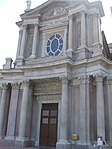Piazza San Carlo
Italy stubsPiazzas in Turin

Piazza San Carlo ("St. Charles Square"), previously known as Piazza Reale, Piazza d'Armi, and Place Napoléon, is one of the main city squares in Turin, Italy. It was laid out in the 16th and 17th century and is an example of Baroque style. The 1838 Equestrian monument of Emmanuel Philibert by Carlo Marochetti is located at the center of the square, which is surrounded by porticos designed by Carlo di Castellamonte around 1638. The twin churches of Santa Cristina and San Carlo Borromeo close the southern edge of the square.
Excerpt from the Wikipedia article Piazza San Carlo (License: CC BY-SA 3.0, Authors, Images).Piazza San Carlo
Piazza San Carlo, Turin Centro
Geographical coordinates (GPS) Address Nearby Places Show on map
Geographical coordinates (GPS)
| Latitude | Longitude |
|---|---|
| N 45.06773 ° | E 7.68259 ° |
Address
Emanuele Filiberto
Piazza San Carlo
10123 Turin, Centro
Piedmont, Italy
Open on Google Maps











